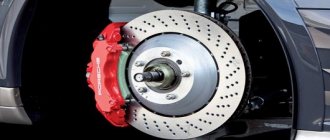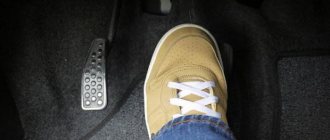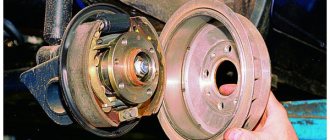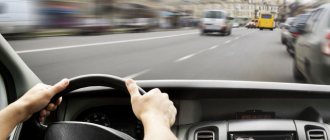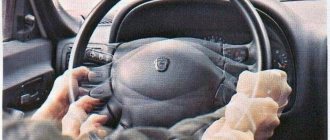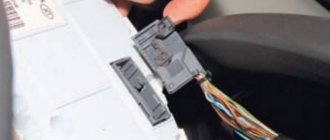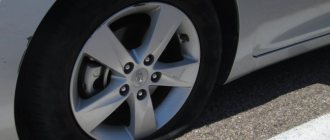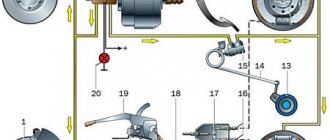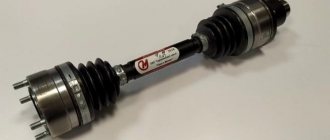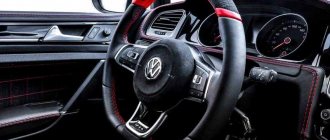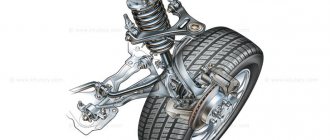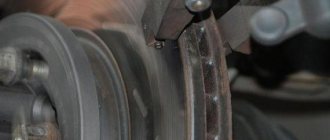Elimination of squeaking for caliper and disc brakes
Of course, creaking is easily eliminated, although it may be a temporary phenomenon due to the time of year or weather conditions, but in any case, recommendations for eliminating creaking will be useful to both beginners and experienced cyclists.
- Keep the wheel rim clean. Periodically degrease the rim with solvent or white spirit. This will allow you to get rid of traces of the pads that have stuck to the surface. As a rule, this is visible to the naked eye and appears as black marks from braking. You can also lightly use fine sandpaper on the rubber pads. The squeak should disappear and the grip of the brake system should improve.
- If disc brakes on a bicycle squeak, you should check that the system is installed correctly in relation to the rotor. There should be no distortions, and the clearance between the pads and the disc should be minimal and the same on both sides. Although disc brakes are less likely to get dirty due to their location, they are still sensitive to cleanliness. Periodically degrease the rotor and disc.
Why do brakes squeak and how to get rid of it?
Creaking pads is a fairly common phenomenon that haunts many car enthusiasts. And what’s most unpleasant is that creaking does not always occur on used cars, but on completely new cars that recently graced the window of some showroom.
I will try to tell you why brakes squeak or whistle, and how to get rid of it in this article.
The squeaking of brake pads does not always mean a decrease in braking efficiency; rather, it is a test for the nervous system of those inside the car. The unpleasant sensations are also complicated by the fact that it is not so easy to understand or detect the cause of squealing brakes, since there may be several of them.
Posts 1 to 20 of 22
1 Topic by Jungle 2014-03-11 11:10:54
- Jungle
- Participant
- Inactive
- From: Unecha
- Registration: 2014-03-11
- Messages: 130Thanks: 14
- Car: VAZ 2111 1.5i 16v
Topic: Resolved: When braking the engine behind the panel there is a strong crackling sound near the VUT (video)
Hello! This problem has been bothering me for a long time, I can’t find the reason. When braking the engine, a strong cracking sound is heard behind the panel, approximately in the VUT area. You squeeze the clutch or add gas and it stops. The crack is powerful, it’s unlikely that something came loose or came loose from the plastic. Tell me, please, what could it be? Maybe VUT itself?
2 Reply from igorek 2014-03-11 14:58:42
- igorek
- Brother-in-law
- Inactive
- From: Bryansk region g Starodub
- Registration: 2013-05-05
- Messages: 416Thanks: 191
- Car: VAZ-21102 1.5i-8V Bosch MP7.0H
Re: Resolved: When braking the engine behind the panel there is a strong crackling sound near the VUT (video)
?I?I. I??jungle, look at the condition of the engine mounts.
3 Reply from Jungle 2014-03-11 16:50:04 (2014-03-11 16:57:35 edited by Jungle)
- Jungle
- Participant
- Inactive
- From: Unecha
- Registration: 2014-03-11
- Messages: 130Thanks: 14
- Car: VAZ 2111 1.5i 16v
Re: Resolved: When braking the engine behind the panel there is a strong crackling sound near the VUT (video)
The crash seems to be coming from inside the cabin.
4 Reply from TOPIC 2014-03-11 17:22:37
- SUBJECT
- New member
- Inactive
- Registration: 2014-03-11
- Messages: 21Thanks: 9
- Car: VAZ 2111
Re: Resolved: When braking the engine behind the panel there is a strong crackling sound near the VUT (video)
Look at the place where the box cushion is attached to the body. A friend of mine has an 8 valve VAZ 2110, this place is all cracked with cobwebs and the sounds were also not pleasant.
Interesting Facts
Some new brake pads have what is called a primer layer. It is located above the main friction material. After installing such a new pad, when driving for the first 50.100 kilometers, a squeaking noise may occur due to the rubbing of the pads and wear of the initial layer. That's why new pads squeak after replacement. This should be taken calmly and taken for granted. However, in order to save nerves, before purchasing certain brake pads, it is necessary to clarify information about whether they have the mentioned initial layer.
Sometimes pad squeaking also occurs on drum brakes. A striking example of this is the popular Renault Logan car. He has a so-called childhood disease, which is expressed in the fact that during heavy braking, the pads (especially new ones) can cling to the support shield. The elimination of this drawback, which means that the pads do not cling and creak, consists of rubbing the friction point with sandpaper.
Also, occasionally, metal chips stick to the disc and drum brake pads. It causes a quiet squeak and a decrease in braking efficiency. To get rid of this phenomenon, you need to dismantle the pads and remove such deposits using fine sandpaper
Please note that you need to work carefully so as not to damage the pad and its working surface
Conclusion
The search for the reasons why brake pads squeak should always begin with checking their condition. Most often, especially on cars with high mileage, their owners simply forget to replace them, and the pads create a squeak during braking due to wear. Remember that the pads must be changed in accordance with the requirements of the manufacturer of your car. They are often allowed to be used until they reach critical wear. On other cars, the pads need to be changed after a certain mileage (for example, 30 thousand kilometers).
If everything is in order with the pads, then you need to carefully check the above-mentioned components and elements of the car’s brake and chassis systems. Remember that repair work must be carried out responsibly so that the car’s brakes work flawlessly in the future!
What to do if your brakes squeak
Perhaps the least obvious way to get rid of squeaking brake pads is to create cuts on the pad. This method is used both by reputable companies producing similar products and by garage craftsmen who have appreciated the effectiveness of this method. The essence of this method is that any creaking is vibration. Accordingly, dividing the vibrating array is an excellent way to change the vibration frequency. To do this, you need to make several cuts on the working surface of the block. But, if the manufacturer, dividing the block in this way, has an idea of how this will affect its performance and reliability, then you perform such an operation at your own peril and risk.
Sometimes lubrication of the guide calipers with a special product helps eliminate squeaking. And when replacing pads, all elements of the brake system that may need it should be lubricated.
Complete with brake pads, you can often find special anti-squeaking agents. These are plates that are installed between the brake pad and the piston. Such plates are designed to provide a tighter and more uniform fit between the pad and the brake disc. If the pads you bought do not come with such plates, you can purchase them separately.
Rounded edges on brake pads are another way to reduce vibration. This configuration allows the blocking force of the pad to be made more gradual, thereby reducing the level of vibration of the pads.
Algorithm for proper cleaning of bicycle brakes
Let's use the schematic (step-by-step) instructions:
- First you need to make sure that the brake system is squeaking.
- After isolating the problem, we proceed to dismantling the brakes.
- First of all, unscrew the locking pin and remove the wheel.
- Then loosen/remove the brake rotor.
- We clean the disc using a special lubricant or oil can (if necessary, remove heavy dirt with sandpaper).
- We are trying to achieve maximum evenness of the contacting metal elements.
- Next, wipe the disc with a napkin and perform a similar procedure with the brake pads. As a result, we get 2 even elements.
- The brake rotor is installed back on the wheel.
- After aligning the pads, the locking pin should be in its rightful place.
Congratulations, the brake system has undergone preventive diagnostics and is ready for full operation. In order for the system to “get used to”, it is necessary to perform several sharp braking at a driving speed of 20-25 km/h.
Poor quality pads, discs or uneven wear of elements
Brake pads and discs are consumables for a car, so car owners often purchase and replace these components on their own. Purchasing spare parts does not always happen from official suppliers; original parts are often unreasonably expensive. Therefore, we expose ourselves to certain risks by purchasing analog parts or spare parts of unknown origin. In this case, a huge set of problems is possible, which will become the main cause of problems and squeaks in the braking system:
- incorrect composition and insufficient softness of the metal in the working part of the brake pads;
- poor quality of metal in brake discs, lack of required strength and rapid wear;
- uneven wear of discs and pads, which causes ineffective braking and problems with automation;
- consumables fail too quickly, unexpected braking problems;
- poor efficiency and strong heating of discs and pads during friction, problems with the entire braking system;
- other classic problems when installing non-original equipment for your car.
These are the types of problems that can be caused by installing non-original pads and discs. This does not mean that you should necessarily spend money only on original parts, but you should not buy spare parts from an unknown manufacturer. It is better to increase maintenance costs and get high quality work of all machine components than to have problems with transport and with the main safety devices. By the way, if braking is ineffective and there are problems with the elements of this system, ABS and other safety devices also do not work. This makes the car defenseless against some types of obstacles, as well as when attempting emergency braking.
A knocking or squealing noise caused by brake rotor rust that can appear overnight
You will be surprised, but rust on brake discs can appear very quickly. Especially if there is a lot of moisture outside. So don’t be surprised if you notice a layer of rust on the brake discs of your car, which has only been sitting for one night. Keep in mind that rust may cause squealing, whistling, and even knocking noises when braking.
Especially in the morning, when you are just leaving the parking lot near your house. But after a short time, this sound should go away, as the brake pads, pressed by the calipers, quickly polish the surface of the brake discs, making them shiny and smooth again.
Why do new brake pads whistle and squeak?
- Incompatibility of materials. The braking part of the pads (friction) is made of various materials. Each manufacturer has its own optimal combination of braking properties and durability, which is kept secret, because competition in the market is significant. The higher the rigidity of the material, the more effective the braking properties. At the same time, there is a possibility of a vibrating effect of the rigid plane, and, as a result, a whistle or squeak. When using softer materials, the opposite situation occurs. The likelihood of whistling and squeaking is much less, and the part wears out much faster. If the brakes whistle after replacing the brake pads, there are two possible reasons: The material from which the friction part of the pads is made is not compatible with the material from which the brake disc is made. It is recommended to select products from another manufacturer. The braking surface of the pad is covered with a protective layer and makes a whistle immediately after installation. It is recommended to drive around such parts for two to three days, and then the whistle will disappear.
- Metal shavings that are an integral part of the material from which the brake pad is made. Typically, shavings or threads of light alloy or soft metals are used: copper, lead, antimony, brass. Metal inclusions in the pad material remove excess heat from the pad. After all, with constant braking, overheating of parts is possible. If the production technology is violated, and there is more metal in the lining or it does not meet the standards, then creaking is possible when braking. Among other things, such pads can seriously shorten the service life of the brake disc.
- Design features that reduce the likelihood of squeaking. Metal plates installed between the piston and the pad to secure it serve to eliminate gaps, reducing vibrations and, therefore, reducing the likelihood of squeaking and whistling. The pads of many well-known manufacturers are equipped with these anti-squeak plates. If they are missing, you can purchase and install them separately. The brake pad design can be made with a friction part in the form of one, two or three segments. This has a direct effect on the occurrence of vibration: a smaller area leads to an increase in frequency, respectively, a decrease in whistling or its complete absence.
- Brake disc wear. A warped disc is one of the reasons why disc brakes squeak. The problem may arise when driving into a puddle with heated brake discs, during intense braking, water hammer or overheating of the disc. It should be noted that any pads will produce grinding noise and extraneous noise on a curved disc, and you can only get rid of it by replacing the old disc with a new one, since regrooving the disc does not always give a positive result.
- Other malfunctions. These include all malfunctions that arise during the operation of the car, such as wear of the wheel bearing or parts of the brake mechanism, old brake pads that have become unusable. In such cases, not only a whistle may appear, but also a metallic grinding sound of the disc on the pad, which does not have a friction coating. When wear occurs, it most often results in a rattling or rattling sound when moving.
- Atmospheric influence. Severe frost, high humidity, slush, and driving on dirt roads can also cause squealing brakes. In such cases, it disappears in dry weather. If foreign objects get on the rubbing surfaces, it is enough to remove them or wash the brake mechanism.
How to deal with grinding?
If you hear a grinding noise on the front wheels when braking, the easiest way is to replace the pads with original ones. Such a solution cannot be called economical, especially when the parts are completely new. In addition, there is no guarantee that the method will work. First advice: do not rush to buy spare parts; first you should take a number of actions:
- Check the mechanisms for leakage of brake fluid and oil in the rear wheels. If a leak is detected, repairs must be made and the rubbing parts must be thoroughly cleaned.
- Try running in newly updated pads by performing a few hard braking sessions.
- Carry out diagnostics of the chassis and the performance of the brake mechanisms. Loose guides, calipers and wheel bearings should be replaced.
Note. Sometimes simple washing and cleaning of work surfaces helps get rid of squeaking. Dirt and sand falling between them can cause a whistle and definitely provoke accelerated wear of the contacting planes.
What should a car enthusiast do when the above measures do not produce results:
- pads worn to the limit - definitely replace them;
- try to cut grooves on the working part yourself, dividing it into 2 sectors;
- carefully file the surfaces along the edges to reduce the contact area;
- If the squeak does not disappear after replacing the pads, you will have to grind the discs.
Simply incompatible
The pads are not always to blame for the appearance of extraneous sounds, because they work “in close contact” with the discs. The sound quality depends on the compatibility of the friction lining and disc materials. The same pads can completely suit one car owner and greatly irritate another with their squeaks. Ideally, the components of the friction pairs should be manufactured by the same manufacturer: this minimizes the risk of “incompatibility”. But there is still no guarantee that the brakes will work quietly.
Wear - critical
Those who are used to calling in for service only when the car breaks down have probably encountered this situation: the pad lining is completely worn out, braking occurs with a metal plate (base) on the disc. More often than not, this is caused by ignoring timely diagnostics and maintenance. But don’t rush to just install new pads - perhaps one of the pistons is jammed, as a result of which
and increased wear occurs. It is easy to determine the malfunction: other pads in such cases are in a much more efficient condition.
Of course, sounds when braking have nothing to do with its effectiveness. However, we can say that squeaking does indirectly affect safety: it provokes the driver to use the brakes less often and makes him nervous every time he presses the pedal. So, if getting rid of loud brakes does not require a lot of money and time, it is better to deal with them as quickly as possible.
Principle of operation
All hydraulic brake systems operate on the same principle:
When you press the brake, the pressure in the brake hydraulic system increases, the brake calipers, through the pistons, press on the brake pads, which are pressed against the disc or drum and, due to the frictional force, slow down or stop it. The pressure (of the calipers) in the brake system directly depends on the force of pressing, that is, on the distance that the brake pedal has traveled. In other words, by pressing the force, you can regulate the pressure and change the braking torque, that is, slow down, or vice versa, with full pressure, you can brake urgently.
The source of unpleasant, extraneous sounds in the brakes can only be moving parts:
- pads (front and rear);
- caliper (piston);
- brake discs or drums (deformation);
- brake pedal (lubrication);
- wheel hub (play);
Most common problems
Braking
Since squeaking brakes when braking is one of the main complaints associated with this problem, a whole range of measures is needed to diagnose and eliminate the defect. It is necessary to identify the side that is squeaking, remove the wheel and evaluate the condition of the brake pads.
Measure the runout of the brake disc, the presence of a service groove and, if necessary, grind (on a special machine - stand) or replace the brake discs (if there is a malfunction, a pair of brake discs is always replaced).
Check the presence of metal anti-squeak plates and their condition, make sure that there are no foreign objects in the brake and wheel mechanism, and also evaluate the condition of the suspension and brake caliper parts.
If after checking there is still a squeaking sound when driving, then most likely there is a mismatch in materials, and you should simply replace the brake pads.
Rear brakes
There are many cars with rear drum brakes, and although the design of the brakes is different, the principle of checking and repairing is approximately the same. The rear brakes are used as a parking brake, and sometimes the rear brakes squeak due to the need to simply adjust the handbrake.
When driving
This usually happens when the wheel bearing wears out or the brake disc is bent, when axial vibrations occur. The brake disc reaches the pad and causes vibrations, heard as creaking, squeaking, and so on. Usually eliminating the backlash and replacing parts (discs and pads) eliminates the problem.
Brake pedal
Braking system defects can also include squeaking brake pedal. Such a squeak usually indicates increased friction on the pedal axle. This can have a critical impact on vehicles equipped with ABS, as increased pedal resistance may adversely affect performance. It can be easily eliminated by simply lubricating the bushings and axle with a suitable lubricant.
If, after all the work and activities, the squeaking noise does not go away when you press the brake pedal, you need to turn to professionals, since the braking system is a complex mechanism responsible for safety and even such a small thing as a squeaking sound should not be ignored.
Causes of squeaks
In the last century, antifriction material was attached to the base of the pad with rivets, the heads of which were recessed into the lining to a certain depth. When critical wear occurred, the metal of the rivet rubbed against the disc, producing a creaking sound. It served as a sure sign that the linings had thinned to a minimum and needed to be replaced.
Nowadays, the fastening of anti-friction elements is done in a more technologically advanced way, so friction of the rivets on the disks and drums is eliminated. There are several common reasons why modern brake pads squeak when you press the pedal:
- Natural wear of the working surface.
- Unevenly worn brake drum or disc, presence of deep scratches.
- Incompatibility of the material or coating with the system of a particular vehicle.
- There are no special grooves or curves to prevent the occurrence of grinding noise. Other design features.
- Wear of certain parts of the vehicle's chassis - calipers, guides, pistons and wheel bearings.
A secondary cause of squeaks at the front of the car is the ingress of water, dust, dirt and process fluids onto the working surface of the disc. The latter include various oils and brake fluid leaking from under the soggy cylinder cuffs.
Drum systems are better protected from external influences, but transmission oil from the rear axle gearbox often penetrates there when the oil seal is worn out. The malfunction can be easily traced by drips on the inner plane of the rear hub.
Checking the condition of the upper strut supports
This part in the car suspension design is designed to connect the shock absorbers to the body. To significantly reduce the load on the body, a special vibration damper is provided, which consists of a bearing and a rubber damper. Wear of the rubber elements of the struts is accompanied by the appearance of a dull knock. In addition, the presence of a malfunction can be detected by measuring the distance between the limiter and the support. In normal condition of the unit, it should not exceed 10 mm. Please note that on some vehicle models, due to the design features of their upper supports, it is impossible to perform these measurements.
The problem must be diagnosed using another method. It is based on vibration detection in racks. It is worth swinging the front of the car from the side of the rack being tested, after placing your hand on the “glass” at the place where it is attached. The presence of beating indicates wear of the damper or bearing. In addition, you should check how well the nut that secures the support is tightened. It is quite possible that this will be the cause of the vibration.
Thank you Dislike Gromozeka Oct 27, 2010
My rear right one is also nonsense, more precisely, it knocks when you brake, the faster you go, the louder it gets and it hits the pedal (it feels like it’s hitting in one place on the wheel). To be honest, I don’t know what to do anymore, I took it apart, looked, cleaned it - everything OK, no scuffs or chips, I drove it and on the second day the same thing happened ((I hung up the wheel, everything was fine, nothing was damaged. I took it apart again, decided to change the drums, as the wear was quite severe, changed the springs, sharpened the bolts, swapped the pads ( They were changed 2 months ago along with the brake cylinder), installed it and was happy for 2 days, then a knock appeared, although not so strong, the brake pipe does not cling to the brake. What else could it be.
+1 similar problem, but it appears mainly in wet weather, or at high speed.
Assessing the condition of shock absorber struts
The shock absorber itself very rarely makes extraneous sounds.
And if this has already happened, therefore, the part is in extremely unsatisfactory condition, and in the future simply cannot be used on the vehicle. The simplest and most common method of checking shock absorbers is to rock the car from the side where the suspected source of the problem is located. If, at the time of rocking, the car body smoothly takes its original position and there is no extraneous noise, therefore, the shock absorber strut is in good condition. If, after swinging, the shock absorber has difficulty lifting the car body, most likely the level of working fluid or gas in it has significantly decreased. This may be caused by a leak in the seal of its housing. In addition, when braking or coming into contact with road potholes, the faulty element cannot completely dampen body vibrations, as a result of which they are clearly felt in the cabin.
If during visual diagnostics it was not possible to determine whether the shock absorber is working or not, it must be removed from the vehicle for a detailed search for the problem.
Noise when braking that is not related to the brakes
There is another noise that can occur when braking. It is noteworthy that it is not directly related to any malfunction. Technically, this noise has to do with the brake discs. If so, we should mention this noise in our article. By the way, many drivers, having heard noise associated with this problem, think that there is a malfunction in the car’s brake system. So what is this noise?
If your car makes a scraping sound when driving or turning that sounds like something akin to a tin can rattling, you may have caught a rock in the road that has become lodged in the brake system. Most often, stones get lodged in the space between the brake rotor and the backing plate, resulting in a terrible sound. To get rid of it, simply remove the stone. Sometimes the cause of the noise can be the brake disc backing plate, which, bent, touches the disc, scratching it.
Another way to remove a stone stuck behind a brake rotor is to bend the backing plate slightly as shown in the video below:
Messages 14
1 Topic by shel 2014-11-13 08:41:42
- shel
- New member
- Inactive
- Registration: 2013-10-08
- Messages: 14Thanks: 1
- Car: VAZ 2110
Topic: Rear wheel grinding when braking
Hello everyone! I have a new problem. This means that when braking (only when braking), a friction sound appears (grinding) in the rear right wheel. Yesterday I went to the service station, they removed the drum, the pads were fine, the cylinder was leaking, they replaced it. started pumping the brakes, the pedal pumps up but doesn't release. Somehow, with the handbrake raised, it started to drop a little and pumped it up. but the pedal did not fall all the way; the service station workers do not know why. They had an assumption that the problem was in the main brake, and the sound of friction (grinding) did not disappear... so I left with nothing... the only thing that was replaced was the cylinder. Maybe someone had something similar? Please share.
2 Reply from fade353 2014-11-13 09:34:45
- fade353
- Experienced
- Inactive
- Registration: 2014-07-16
- Messages: 404Thanks: 70
Re: Rear wheel grinding when braking
Pull up the handbrake, if that's the problem, you can pull it a click or two, the grinding noise should go away.
3 Reply from iliaBkmz 2014-11-13 11:27:07
- iliaBkmz
- Forum legend
- Inactive
- Registration: 2012-11-12
- Messages: 2,035Thanks: 583
- Car: outlander and 2104
Re: Rear wheel grinding when braking
Never set foot on this service station again! In order to pump up a sorcerer’s butt, you need to “tug” it - otherwise you won’t be able to pump it up mentally. What kind of service station is it if they don’t know this. In the final pumping - the car should be level or suspended on a lift (but then you need to clamp the “sorcerer”) and the pressure should be the same in both cylinders - otherwise you need to look at what’s wrong with the “sorcerer”. And the grinding noise is most likely the inside of the handbrake . But if the “sorcerer” has turned sour, one wheel can slow down, and the other can barely touch the pads - which is most likely (judging by the description) what happens. But as I understand, you won’t be able to do it yourself, so it’s worth finding a normal service station with competent craftsmen, since from the description you can’t determine the problem 100 percent, but I indicated the direction. Good luck
VAZ 2114 grinding noise when pressing the brake
Then I took sandpaper and rubbed the pads and drum. After installation, after one braking, the grinding noise went away!
. But now there is another problem: when braking from a speed of more than 70 km/h, vibrations appear on the brake pedal. Sometimes mild, sometimes noticeable, the whole car vibrates.
Had the same problem. It turned out to be dirt. I cleaned it, everything went away. But now there is another problem: when braking from a speed of more than 70 km/h, vibrations appear on the brake pedal. Sometimes mild, sometimes noticeable, the whole car vibrates.
Apparently the drum(s) were placed differently from how they were previously on the hub (180 degrees) and now there is radial runout. Jack up the rear wheels one at a time and see if they brake evenly; if not, turn the drum (or both) over. Advice for the future: you need to mark the position of the drum on the hub before removing it.
Cured! Yesterday I was at the service station, they removed the drum, but my left cylinder doesn’t work at all, and the right one works, but it’s leaking. Changed the cylinders. Now everything is fine!
We looked at what other problems there were. They said the front brake discs should be replaced, because there is already quite a lot of wear there, 3 mm left. They showed that my rocker seal and drive seal were leaking.
But damn, it’s still very expensive for them to replace brake cylinders. I was inside all the time. In fact, nothing complicated, remove the old one - install a new one, 15 minutes for each cylinder. And it costs 600 rubles to replace ONE. + handbrake adjustment — 180r. Horror!
The grinding noise constantly intensifies and is quite sharp.
One of the most common situations in which you will need to use the help of specialists at a service station is an increase in grinding or a sharp, strong sound of metal rubbing against metal. Most likely, the block is completely worn out; you continue to brake with the sole of the block, which is made of hard metal. If this problem is not addressed promptly, the brake disc may fail and require replacement. In this case, repairs will be three times more expensive, so it is better to immediately identify all possible malfunctions and problems that caused the grinding noise when braking. In particular, to diagnose this problem, it is enough to carry out the following processes:
- determine from which side the grinding sound is heard, this will help you halve the amount of work required for diagnosis;
- remove the wheel that you suspect is making unpleasant sounds when braking;
- examine the exposed brake disc for grooves, chips and other problems with the working surface;
- look at the remaining layer of the brake pads, determine the degree of wear and the need for replacement;
- also examine the second wheel on this side, and best of all, examine the braking system on all wheels;
- Identify possible problems that could lead to squeaking and consult with specialists.
This will often help you determine the cause of the squealing noise when braking for free, but disassembling the brake system and performing repair work yourself is not always wise. You can use the services of specialists and guarantee the normal operation of the brake system. However, it is quite possible that all braking systems visually appear to be in good working order, but the grinding noise is still present. Then see if the car's behavior has changed during braking. If there are changes, you will have to pay more attention to this problem. If there are no changes, you can continue to operate the car until the grinding noise intensifies and gives specific clues.
A harmless grinding sound - when can you ignore the sounds?
If extraneous sounds in your car are simply caused by poor quality pads, it is better to immediately change this element and not wait until the pads completely fail. But if good pads contain inclusions of harder metal, this feature is not dangerous for the discs. You can safely continue to operate the car. Only in the event of a sudden change in the behavior of the car when braking and in some cases, when the grinding noise begins to annoy with its intensity, can you consider replacing the pads and discs. Otherwise, it is enough to make sure that the nature of the sound is as follows:
- simply functional features of the working part of the pads, which contain unknown elements;
- the brake disc is not factory, which caused its rapid wear and grinding when braking;
- The grinding noise goes away after intensive pressing of the brake pedal;
- the creaking or other sound is not too annoying, it does not get louder and does not interfere with a normal trip;
- with the windows closed, you can hardly hear the squeaks of the brake system in the cabin, there is no extraneous sensation on the pedal;
- after 10-15 thousand kilometers the squeak disappears or noticeably subsides.
In other cases, it is worth paying more attention to the nature of the grinding noise when braking. If the grinding noise means your brake system is beginning to fail, you should take action quickly and save yourself a lot of money. If you delay the repair, you will have to change all the pads, all the discs, as well as other braking systems that may stop performing the necessary functions due to too much heating. It is also important to contact a good technician who can examine the entire braking system, conduct high-quality diagnostics and find other problems. This will allow you to return your car to normal operation. We suggest looking at information about pad wear and squeaking in the front suspension on a Chery QQ car:
The principle of operation of the car's brake system
All modern brake systems work according to the same type. The work takes place in several stages:
- When you press the brake pedal, the pressure in the hydraulic brake system begins to gradually increase;
- The increased pressure in turn causes pressure in the brake pads;
- The pads, in turn, transfer energy to the wheel housing, which then brakes the car on the road.
Thus, pressure from the driver is transferred to the caliper, which is inextricably linked to the disc. As a result, the force applied to the brakes is directly proportional to the pressure of the disc on the wheels. That is why drivers can control the braking speed with a slight movement of their feet.
At the same time, manufacturers of brake pads and discs have made sure that your vehicle always operates quietly. Let us remind you: when the brake system is activated, the disc is pressed against the base of the wheel, causing vibration. To eliminate noise during contact and prevent strong vibration of the wheel, manufacturers divide the area of the brake pads into several specific segments, each of which has a special cut along the surface. This suppresses the occurrence of squeaking and vibration.
Often, when purchasing brake pads, buyers overlook the fact that there are no slots, which can cause not only squealing from the pads even on a new car model, but also a knocking sound in the front suspension on small bumps. However, you can make slots in the pads with your own hands. To do this, adhere to the following slot parameters:
- the width of the cut should be no more than 2 mm;
- incision depth – 3.5-4 mm.
However, the cause of squeaking in the brake system is rarely due to a lack of slots. We propose to consider the most common problems with brakes and effective methods for eliminating them.
Brake pads and discs
Detection of material incompatibility after purchasing pads and discs
The problem here is related to the fact that each manufacturer keeps secret the composition from which the friction (or in other words, braking) part of the surface of the pads will be made. As a result, due to the mismatch of the material, a squealing noise occurs when the pads and disc come into contact. Since manufacturers are constantly looking for a way to create the most economical pads that will combine high braking performance and guarantee durability, factories cannot come to one patented composition.
The harder the final material is, from which the friction component of the brake pads will be made in the future, the more effective the braking will be. At the same time, hard compounds will cause strong vibrations in the wheel and a sharp squeak. With softer pad compounds, the likelihood of brake squealing is reduced to a minimum, but at the same time they wear out much faster.
If the material of the set of friction linings and brake discs installed on the car is incompatible, a squeaking sound appears. Moreover, it can be heard even when driving on a straight road without using the brake. To solve this problem, simply replace the brake pads with models made by another manufacturer.
Squeaking caused by the surface and design of the brakes
Note that to avoid squeaking in the pads, it is best to select samples of new brakes of exactly the same shape as the old ones. A complete match in shape with the original factory pads will create reliable fastening of the models in the caliper body, which in turn will prevent unnecessary vibrations.
The design of the pad also greatly influences its performance. All modern models have a division of the friction part of the brakes into 2-3 segments. As a result, the mass and final area of the braking segments become smaller, and the frequency of vibrations increases, which makes the whistle disappear. Therefore, before purchasing new samples, check the condition of the pad and disc segments, as well as the location of the cuts. If everything is in order, then the problem does not lie in their design.
Loud noise when braking
A strange strong sound appeared when braking and simultaneously turning the steering wheel. Not always! That is, no. When the brake pedal vibrates in time with the crackling noise. Not like abs, but similar and much stronger. It's getting scary. The pads are new, good Japanese ones)) After the replacement everything was ok. But then 1000 km and... The car brakes well. Has anyone encountered something similar?
Last edited by rozfeel; 06/16/2010 at 21:31.
So what is the sound when braking? Is there a crackling sound in the title of the topic, or is there some kind of sound? or does the pedal hit when braking, that is, when you press it, does it move back and forth? Probably the brake discs are still weak, when braking at speed there is no vibration on the body and pedals? or look at the disk protection, you can draw it somewhere but there is no vibration from it
And fill out your profile completely
The cracking sound is like “tr-r-r-r-r”. Strong. And the beating in the pedal is not just noticeable, but strong. There was no speed. Only when I turned the wheels a little and the speed was not high. Those. I had to slow down when turning and then it was like “tr-tr-tr-tr-tr.” And as I said, this is not a rule. Those. the sound is there or not.
I don’t know if this is related or not, but recently when braking to a complete stop there was a strange sound coming from under the hood. It’s as if something is moving out of place, like a grinding noise, but not quite. The sound was not strong but noticeable. Everything is secure under the hood))
If the brake disc is worn, does it need to be bored? Or is it all bullshit and should I buy new ones? I'm going to remove the wheel, when time comes, will there be any external changes on the disk or will I not see anything? Thank you.
rozfeel
, the sound TR-TR-TR and hitting the pedal is the ABS is triggered. If it works when you press the pedal lightly, then it seems like you need to look at the combs and check the sensors. As for the brake discs, you can sharpen them if the wear is not large, but if the wear is large, it is better to buy new ones.
Not ABS, that's for sure. I know how ABS works - easy trrr. And here it’s 10 times stronger and a little bit the frequency of a friend.
Addition: Now I braked in a straight line hard until it stops and until it stops completely. Just before stopping from 5 km/h to 0, there is a grinding sound from the front, the sound is different from what I described: there is no beating on the pedal and “krrrr” instead of “tr-tr-tr-tr”. )) But there seems to be one reason. I looked at the discs 1000 km ago, they were still very good, and I changed the pads with professionals, they would have told me. But apparently they are. What else?
Means for eliminating squeaks
In order to get rid of extraneous noise in the car interior, special seals and lubricants are used.
"Anti-creaks"
This is the name of synthetic products designed to seal gaps and reduce friction of surfaces in the car interior:
- Bitoplast is a porous sheet 5-10 mm thick, impregnated with a special hygroscopic composition and one adhesive side. It is carefully applied to the degreased internal surfaces of interior elements to remove squeaks and improve sound insulation in the car.
- Biplast is a porous, fine-mesh material with a “memory effect” that can be strongly compressed when installed between rubbing surfaces. Trying to restore the original shape, the mass completely fills the gap and seals the connection of parts, allowing it to deal with strong vibrations, external noise and squeaking.
- Madeline is a decorative material with a thickness of up to 1.5 mm and good sound-absorbing properties, which is used to eliminate the smallest gaps and improve sound insulation.
- Anti-squeak aerosol is a harmless, odorless, non-flammable polyester oil that is applied to rubbing plastic surfaces and creates a noise-absorbing anti-corrosion film.
Silicone wax
This product, containing silicone oil with a thickener, is available in the form of a spray, gel or paste.
The gel is applied to the rubber and plastic surfaces of the car and protects the rubber and silicone seals of windows, doors, hood, trunk lid, rubber suspension elements and shock absorbers. Locks and wiper blades are also treated with silicone wax.
Silicone paste wax allows you to eliminate external and internal squeaks in the car interior. It is resistant to temperature changes and high humidity, plastic, transparent, adheres well to surfaces, does not burn, and is safe for humans.
Silicone spray is able to penetrate hard-to-reach places and cover large surface areas with a thin protective film.
To prevent stains from remaining on the plastic, the applied product must be rubbed
It is important to ensure that the substance does not get on clothing and does not leave greasy marks on it.
Silicone grease "Suprotek-Aprokhim"
is a well-known manufacturer of new generation lubricants and wax protective additives. The brand's silicone grease is a high-quality product that is easily applied to surfaces, provides them with anti-corrosion protection, and increases strength and elasticity.
The product is sprayed from a can, penetrates deeply hidden and hard-to-reach places in the structure, protects rubber, plastic and leather from abrasions, drying out, cracks and can eliminate noise, squeaks, friction in the fan and gas distribution system, at the joints of seats and interior trim parts.
Lada Kalina and Granta
You can stick a film on all surfaces of the door trim to prevent squeaking. The pistons, having already been removed and installed several times, may also not provide proper pressure to the upholstery, and they themselves may creak in their holes. Such pistons must be replaced. The most radical way to attach door trim is to install one or more self-tapping screws. You should use metal screws, install them in inconspicuous places and close the heads with decorative plugs sold in hardware stores.
How do you deal with squeaks? Are you fighting at all? Share your experience, colleagues!
Let's sum it up
High-quality brake operation in a car is one of the most important features of a safe trip. If operating the machine causes certain difficulties or discomfort in terms of braking, you should immediately contact a service station and solve the problem. Otherwise, you may encounter unpleasant situations when braking turns out to be ineffective at a difficult moment and will not be able to provide the necessary operating features
Considering the importance of the braking system for safety, it is better not to joke with this unit and do all the work on time. Creaking and grinding noises can occur if you do not comply with the manufacturer's important car maintenance requirements. Simply replacing your pads when squeaking begins can save you money, time, and ensure your safety.
To completely avoid trouble, it is enough to carry out the inspection on time and respond to all unpleasant manifestations. The behavior of the car, as well as the sound effects of problems, can also be an important point in diagnosing the car. Often these moments are an important harbinger of problems. What do you do if your car starts making any unnatural noises?
Simply replacing your brake pads when squeaking begins can save you money, time, and keep you safe. To completely avoid trouble, it is enough to carry out the inspection on time and respond to all unpleasant manifestations. The behavior of the car, as well as the sound effects of problems, can also be an important point in diagnosing the car. Often these moments are an important harbinger of problems. What do you do if your car starts making any unnatural noises?
Brake noise: trivial or dangerous?
“Squeaking brakes” is one of the most common complaints from drivers about car brakes. Brake noises can be annoying, but not indicative of any problem, but they can also warn us of a possible danger. It is better to be careful and determine the cause of the noise in the brake system by taking the car to a mechanic.
We'll cover three of the most common brake noises that thousands of motorists encounter every day, shedding light on what causes them and giving tips on how to get rid of them. Some methods for eliminating noise are unconventional, and you will never find them in a car service manual or even, perhaps, in books on car repair.
Let's look at three of the most common problems that cause brake noise.
